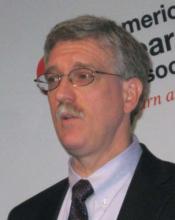When the highly-anticipated results from the TOPCAT trial reported last November failed to show a statistically significant efficacy benefit from spironolactone treatment in patients with heart failure and preserved left ventricular ejection fraction for the study’s primary endpoint of death or heart failure hospitalization, the neutral result represented more than another failed treatment trial in this rapidly expanding patient population that remains bereft of treatments with proven efficacy.
TOPCAT’s results also underscored the heterogeneity of patients diagnosed with heart failure with preserved ejection fraction (HFPEF), a signature feature of the syndrome. Heterogeneity is believed to have played a large role in the lack of success in TOPCAT as well as in several other major HFPEF trials.
Although HFPEF is defined as patients who exhibit clear clinical symptoms of heart failure but with a LVEF of at least 45%, and more recently at least 50%, what’s become increasingly clear as neutral trial results accumulate is that HFPEF is a syndrome. Far from a single pathologic entity, it can have different etiologies and present as different subtypes in a spectrum of abnormalities and severities.
HFPEF "is not just a simple disease of diastolic function and a stiff ventricle. It’s a very complicated, highly integrated, multisystem failure of cardiovascular and peripheral reserve," said Dr. Barry A. Borlaug, a cardiologist at the Mayo Clinic in Rochester, Minn. "A lot of us are coming to the conclusion that there are different subphenotypes of HFPEF, each with unique mechanisms and clinical trajectories that probably need unique treatment," he said in an interview.
"This is a very heterogeneous syndrome with no one etiology and a wide range of patients, some with marked ventricular hypertrophy, some with diastolic dysfunction, some who are fairly asymptomatic but become symptomatic with exercise, some who are compensated and stable, and others who are uncompensated. The spectrum of disease is very broad, and it may be many diseases," said Dr. Scott D. Solomon, professor of medicine at Harvard Medical School and director of noninvasive cardiology at Brigham and Women’s Hospital, Boston.
Last year, the heart failure literature featured two editorials spelling out proposed visions of the HFPEF spectrum. One of these proposed three characteristic types of HFPEF patients (J. Am. Coll. Cardiol. 2013;62:1339-42): those with exercise-induced diastolic dysfunction with no symptoms at rest, minimal fluid retention, and never hospitalized for heart failure but with long-standing hypertension and exercise intolerance; patients with volume overload and edema, recently hospitalized heart failure with dyspnea on exertion, and moderately severe heart failure symptoms; and the worst form, patients who have developed pulmonary hypertension and right ventricular failure as a consequence of their HFPEF and now have frequent heart failure hospitalizations. But patients do not necessarily progress from one severity stage to the next, noted Dr. Sanjiv J. Shah, a cardiologist at Northwestern University, Chicago, who wrote the editorial.
"Patients can progress back and forth across the spectrum" or remain in one stage, he said in an interview. "The syndrome is quite heterogeneous, not only in clinical presentation, but in etiology, and pathophysiology. There is still much to learn about the natural history of HFPEF , how it develops, and the trajectory of patients."
The second editorial described several relatively common HFPEF phenotypes that can appear individually or in combination, including filling limitation, ejection limitation, cardioacceleration, and vasoregulation (Eur. Heart J. 2013;34:1393-5). "Patients with heart failure caused by severe mitral insufficiency or aortic stenosis will clearly behave differently and respond to treatments differently from patients with hypertropic cardiomyopathy, constrictive pericarditis, or high-output heart failure. However, despite this heterogeneity these entities continue currently to be lumped together into the category of HFPEF," Dr. Borlaug wrote in this editorial.
The perils of heterogeneity
In addition to providing a better framework for understanding the causes and consequences of HFPEF, the paradigm of HFPEF as a heterogeneous syndrome also helps explain why the major intervention trials that focused on HFPEF patients, starting a decade ago with studies such as CHARM Preserved (Lancet 2003;362:777-81) and I-PRESERVE (N. Engl. J. Med. 2008;359:2456-67), and continuing through to the recent TOPCAT, have all failed to produce a statistically significant benefit for their primary endpoints.
"Heterogeneity confounds our ability to identify effective treatments. It’s the most likely single explanation" for the neutral HFPEF trials, Dr. Borlaug said. "I don’t think it’s as simple as one thing, but my speculation is that it’s the dominant reason."
"Many trials such as CHARM Preserved and TOPCAT seemed to enroll some patients who in retrospect did not have HFPEF," noted Dr. Gregg C. Fonarow, professor of medicine and associate chief of cardiology at UCLA in Los Angeles. "The key to future clinical trials will be better classification of HFPEF" and better matching of HFPEF patients to their treatment, said Dr. Shah.



